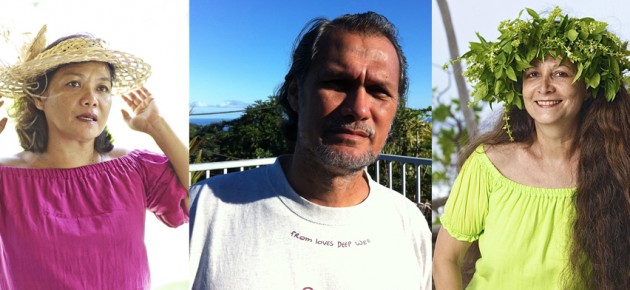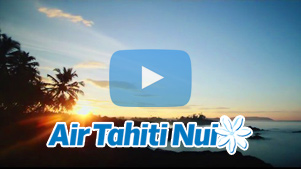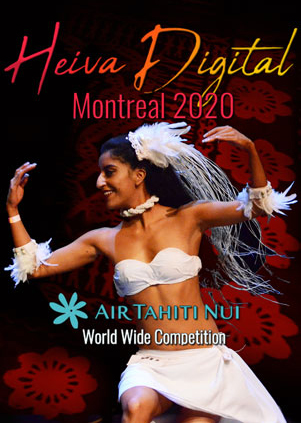The Te Tuamarama Team
The act of creating Ori Tahiti shows requires not only a choreographer and an instructor, but also an author and a music composer. Joelle Berg, Merahau Anastas-Tevai and Libor Prokop are all a part of this Te Tuamarama team. .
In order to portray Ori Tahiti in its entirety, one needs the knowledge of both language and music.
The primary language that is displayed throughout artistic expression is rarely the same language that can be viewed on the streets.
For this reason, dance groups usually have an enlightened author who works alongside them, to write texts but also to search through legends and ancient texts, words etymology, etc. The author of Te Tuamarama is Merehau Anastas-Tevai.
Finally, the creation music of necessitates the work of a skilled musician who will serve a conductor of the orchestra. The musician, composer, and percussion instructor of Te Tuamarama is Libor Prokop.
Libor Prokop
 Libor is a musician who was educated in classical music from childhood. Before beginning his career in Polynesian percussion, he was a pianist and guitarist. During his adulthood, he started learning different drums, the didgeridoo and the nose flute.
Libor is a musician who was educated in classical music from childhood. Before beginning his career in Polynesian percussion, he was a pianist and guitarist. During his adulthood, he started learning different drums, the didgeridoo and the nose flute.
Libor is a master of the toere, the tari parau, the faakete, the pahu, the ihara, and many other traditional percussion instruments, but his specialty resides in the practice of the vivo and pahu. Since the early 1980s, Libor has been a dancer for the Temaeva Dance Group and a percussionist of the Heikura Nui, the O Tahiti, and the Hei Tahiti Dance Group starting in 2012.
He was also a member of the Fenua group of Guy Laurens.
Also, Libor is especially active in the Haururu Cultural Association with whom he researches all aspects of the Marae, or the space and time notions surrounding traditional societies and Polynesian migrations.
Joelle Berg
I discovered a true passion for the art of Tahitian Dancing while studying abroad in metropolitan France. Coupled with my extensive background in the ballet, I began teaching Ori Tahiti (Tahitian Dance) in 1994 and founded my school, Te Oro, which means “Rite” and also “Miri,” in 1996.
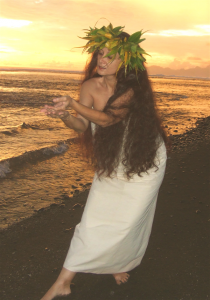 Upon my return to Fenua, which means “motherland” in the Tahitian tongue, I joined the Temaeva Dancing Group. For ten years I trained and danced competitively for Temaeva, taking part in all of their projects and exercises.
Upon my return to Fenua, which means “motherland” in the Tahitian tongue, I joined the Temaeva Dancing Group. For ten years I trained and danced competitively for Temaeva, taking part in all of their projects and exercises.
I have also spent time with the Heikura Nui and Toareva Dance Companies.
I was certified by the Conservatoire upon completion of the Complete Dance Degree Course. Furthermore, I was awarded a gold medal and the Complete Traditional Studies Diploma, which includes oratorical art (Orero), traditional percussion studies, choreographic art, and three years of theoretical education on Polynesian history and culture.
Apart from my dance school, I also take place in the art of choreography. I began working as a dance choreographer in 2001 with Rohotu Noanoa, a show created and produced by TEMAEVA.
In 2002 and 2003 I performed my choreographer duties for the TOAREVA Company. My most notable work was on the show POLYNETIA, which was created especially for the visit of President Jacques Chirac.
Performing in a stadium in front of 25,000 spectators was a unique experience that allowed me to learn new aspects of the creative process.
At this occasion I realized that it is truly difficult to evolve Tahitian dance from the fundamental traditions that currently exist. Despite this realization, I am highly motivated to adapt my own understandings of the dance process into modern forms and styles.
Since 2010 I have been teaching abroad. From Europe to Asia to the United States I organize workshops, master classes, and training courses for dance teachers.
I have also been teaching in my hometown on the island of Moorea since 2010 where I help coordinate activities for the Te Pu Atitia Association, which is directly linked to the University of California Berkeley in Polynesia.
I propose workshops in Moorea and Tahiti during the dance festival of Heiva in July and Hura Tapairu in December.
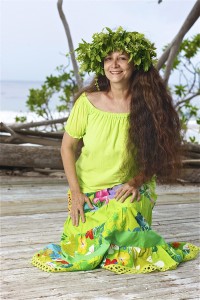 After studying for three years at the Paris Institute of Political Studies, where I specialized in marketing, I studied Business Law, which enabled me to find different jobs within the Territory Administration upon my return to Tahiti.
After studying for three years at the Paris Institute of Political Studies, where I specialized in marketing, I studied Business Law, which enabled me to find different jobs within the Territory Administration upon my return to Tahiti.
I left this field in 1993 in order to pursue my raison d’être, my desire of expression, my participation in life, my way of sharing with others, the field of professional dancing and dance instruction.
Beyond its various facets, in every culture, within every style, through every journey, despite the oddities, dance is an art form and therefore its ultimate purpose will always be of a spiritual nature.
Merehau Konohi Teavai-Anastas
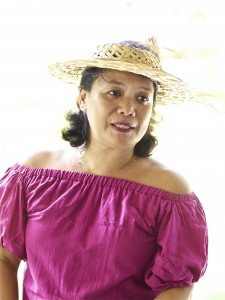 Born in Papeete in 1962, I came from a family that originated in East Tuamotu. I was raised in the Tahitian town of Faa’a.
My island roots of pa’umotu have been an extraordinary influence on my life; they led me on this quest for the meanings concealed in the first texts collected by navigators at the beginning of the 19th century.
Born in Papeete in 1962, I came from a family that originated in East Tuamotu. I was raised in the Tahitian town of Faa’a.
My island roots of pa’umotu have been an extraordinary influence on my life; they led me on this quest for the meanings concealed in the first texts collected by navigators at the beginning of the 19th century.
After completion of my secondary education, I began to study Polynesian languages at the National Institute for Eastern Languages and Civilizations. It was at this institute that I discovered the magic world of languages, language systems, semiological fields, double articulation of language, but above all, the power of spoken words, the power of their bearer, and the purity of the one that receives them. During my years of cooperation with the GIE Tahiti, whose mission was to promote the Tahitian black pearl, I resorted to oral traditions in order to give a meaning and a cultural depth to the product “Tahitian pearl.” This proved to be an exercise in style.
“Poe,” the Tahitian name for the northern star, jewel of light that exists within the luminous night of eternity…
Separate from my work with the GIE Tahiti, I cooperated with dance groups at the Heiva festivals and various other events in order to create unique performances, which allowed me an opportunity to pursue my passions.
What other than Orero could better give life to words in their journey of becoming lyrics? What other than Pupu Himene could better chant this precise chapter of our collective memories, what other than Pupu Ori could better restore the meaning of the forgotten elements?…
I served as the writer for the “O Tahiti E” performance in 1999. I wrote the theme of the show “Te Pakerere,” niau weaving, which is the profane version of the tapaka and the niau shroud… The group secured a first place victory.
In 2004, the economic interest group Perles de Tahiti produced Te Roimata o Oro, “The Tear of Oro,” a theatrical performance that took place in a small ballet formation with 12 artists also from “O Tahiti E.” This theatrical creation was continuously presented on many stages throughout the world at various pearl promotion events.
These two works are built upon many ancient references. In viewing these two performances, the audiences receive an opportunity to witness the reappearance of objects such as the “paau” of the Austral Islands, the “Pakerere” of Tuamotu, the “Kanaenae de Oro”, which is a moon pectoral in nacre, along with the restoration of vegetable matter such as the kere haari, the niau, as well as all other elements of the coconut palm tree.
Joelle’s work with rhythm, movement, and especially the body position and postures used in the execution of Ori Tahiti dance has allowed experimentation in the field of investigation involving what we pompously call Polynesian oral literature.
It is here that we begin to understand the significance of Joelle’s reasoning: to experiment, to analyze, and finally to resort to natural tools provided by the Tahitian language when experimentation protocol reveals signs of a forgery.
Te Pu atiti’a
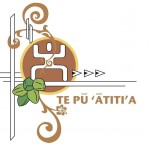
Te Pu atiti’a is a cultural association working from the island of Moorea. Te Pu atiti’a works in close relation to Gump Station, a Berkley University research facility located in the Pacific. Te Pu atiti’a has developed an original approach that consists in combining ancestral knowledge with modern scientific methods in an objective of sustainable development.
Among its members, Te Pu atiti’a has a few “elders” from the five villages of Moorea Island. These “elders” are grouped in a wise council, in order to guarantee the transmission of traditional knowledge.
The association also has contacts with many environmental and cultural associations in Polynesia and other Pacific countries. Te Pu atiti’a serves as an exchange platform between science and traditional knowledge, which plays an important role in community awareness.
The program’s central focus is to maintain the vitality of knowledge from within the Moorea community by consolidating communication between generations.
Learn More About Te Pu atiti’a
The Te Pu atiti’a Association is primarily financed through international sponsorship by the SEACOLOGY and UCB University of Berkeley Foundations.
Along with Science and Educational programs, the association offers the public a variety of activities and cultural workshops:
- tapa making workshop,
- polynesian plants used in dyeing workshop,
- weaving workshop,
- dance and percussions workshops with Joelle,
- tahitian language workshop.
Once a month, Te Pu Atiti’a organizes a traditional market where craftsmen and farmers from the island come to sell their products.
“Ahi ma’a”, a traditional meal is organized at this occasion.







